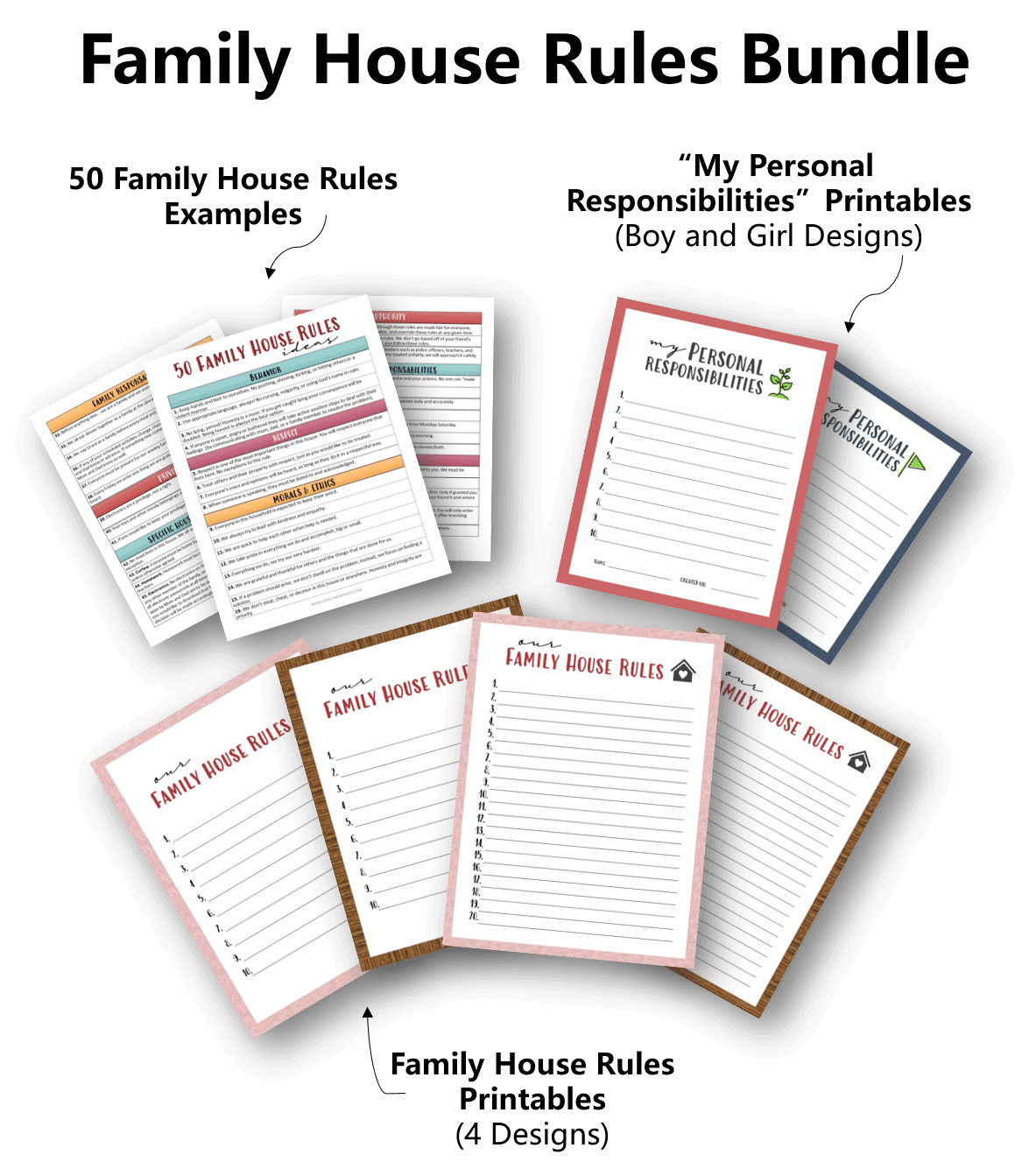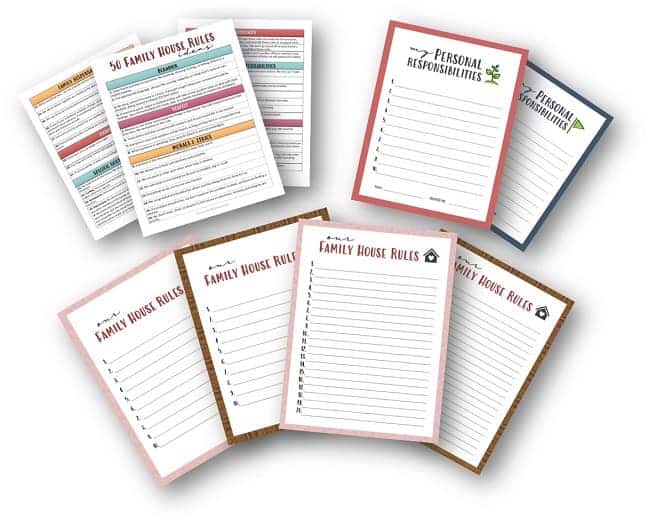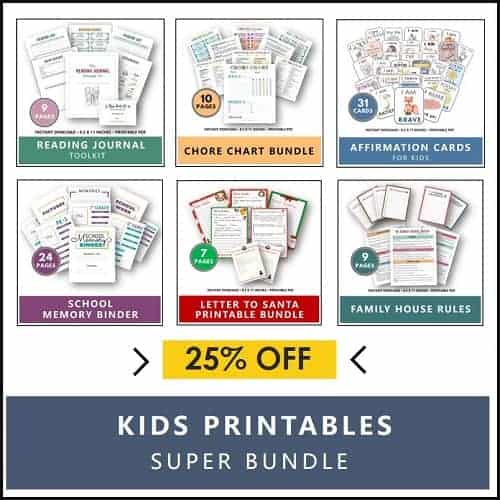Funny Printable Rules of This Home
Would you like to learn how to create Family House Rules for kids and teens that help set a foundation for the standards and expectations of your household?
If you do, you are in luck! Today we will be talking all about not just setting house rules for kids and teens, but also:
- What are Family House Rules?
- The Importance of Family House Rules
- So, why a written list of rules for kids?
- Steps for Creating Family House Rules
- Guidelines and Considerations
- 50 Examples of Family House Rules you can include in your own list
- Printable Templates
There is a lot to cover so, let's get started…

* This post may contain affiliate links. Click here, for more info.
What are Family House Rules?
House rules are simply general guidelines as to how every member of the family is expected to act and behave.
Specifically, family house rules for kids and teens indicate what parents expect from their children based on family values and preferences. In turn, kids and teens who follow family rules are given freedom and choices. Otherwise, consequences result when children do not follow the rules. (More on this later).
This, in turn, creates a better understanding of family dynamics and expectations for every member of the family nucleus.
Importance of Family House Rules
It is no secret that the world operates better with a set of rules in place that everyone must follow. Raising kids is no exception.
Most children will thrive in an environment where there is order, consistency, communication, and discipline.
An article by Paediatrics & Child Health states that"Rules are established for children so they can learn to live cooperatively with others, to teach them to distinguish right from wrong, and to protect them from harm. Children raised without reasonable limits will have difficulty adjusting socially." (Source)
In addition, learning self-discipline enables kids and teens to become emotionally and socially mature adults.
So, why a written list of Family House Rules?
Simple. Written instructions help kids and teens:
- not "forget" the rules
- makes expectation clear
- provides guidelines for actions and behavior
- helps avoid potential arguments
Steps for Creating Family House Rules
So, you know you want to create a set of House Rules for everyone to follow, but where do you start?
Here are a few helpful steps that can help you get started on your house rules. Ensure that everyone in the family is involved in this procedure. Having the kids be a part of this step process is key to acceptance and compliance.
- Step 1: Make a list of common issues that occur in your home.
- Step 2: Come up with family rules that would fix or focus on those issues.
- Step 3: Involve everyone in the rule-making process. Ask for opinions, negotiate, and discuss possible house rules.
- Step 4: Write the rules down on paper. Once the list is complete display them where everyone can see them.
- Step 5: Set and discuss clear and realistic consequences for breaking the rules.
- Step 6: Allow for questions and discussion.
- Step 7: Revise list overtime as needed.
Guidelines and Considerations
Every family has its own dynamic. It is important to base your family house rules on personal goals, family values, and expectations.
There are many approaches to crafting and enforcing house rules for children and teenagers, so here are some important things to consider when creating your own list.
Consider your children's age
Taking your children's age into consideration when creating your family house rules is crucial.
Their age should dictate the number of house rules and the complexity of each rule.
As a rule of thumb, for young children, focus on setting a few of the most important rules at first (3-5). As your child learns to follow the set rules consistently, you can add new rules as you go.
Older children have a higher understanding of following structure and understanding consequences. Therefore, you can get away with a lengthier list (5-15).
If you have a big gap in your children's age, for instance, 3, 8, and 13 years old consider creating the same list for everyone, but you can write 2-3 more simplistic rules for your 3-year-old on that same list. Or you can create a simpler version of the existing ones for your 3-year-old.
Keep it Simple
When making your family house rules keep in mind that they will be made primarily for kids to follow.
Although kids are extremely smart, too much information could be confusing and hard to follow.
While setting too many rules might be too much, little rules might not be enough to achieve the family structure you are hoping for.
So, the number of rules you set should depend on your child's age, and the ability to understand and remember information.
Parents are not excluded
Many parents assume that posting a set of rules that kids can follow will be enough to be effective.
Truth is, that children respond better to rules and expectations that are modeled by their caregivers versus just verbalized.
The reason why it is titled "Family" House Rules is that every member of the family is expected to follow the same guidelines. In turn, creating an atmosphere of fairness and equality.
In other words, writing a few rules on a piece of paper is only a small portion of this exercise… the most significant and successful aspect of creating a Family House Rules is that parents set an example of fairness, honesty, and social responsibility for their children to follow.
However, there are exceptions to this rule as some of them only apply to kids and not parents. You can find a full list of example house rules for kids and teens in the next section.
Be specific
Don't leave anything to the imagination. If you expect something to be done, describe how and when it should happen so that there isn't any miscommunication, confusion, or necessary arguments.
Examples of specific rules are:
"Everyone's chores should be completed by 6:00 pm every night before dinner."
"No electronics are allowed at the dinner table during breakfast, lunch, or dinner."
Get everyone involved
Once again, this activity is a family exercise.
Every member of the family should be involved in creating, discussing, and implementing their family rules.
Provide every member of the family the opportunity to voice their opinion and share their ideas. Kids and teens are more likely to follow the rules when they were a part of the rule creation process.
Be consistent
One of the biggest game-changer in implementing house rules for kids and teens is consistency!
Consistency creates routine, and routine becomes second nature, and THAT is the ultimate goal!
When these important life principles of respect, responsibility, and acceptable behavior towards themselves and towards others become second nature, you have done your job.
Displaying your house rules
Family house rules should be displayed in an area where everyone can see them every day.
Writing and showcasing the family rules helps make them clear, and it can also prevent future arguments about what is or isn't allowed.
Great examples of places to display your family rules list are:
- in a common hallway
- a kitchen wall
- the fridge
- the family room
Check out the Family House Rules Bundle for Printables you can use to display your list!
Review your Family house rules often
Children grow quickly and so does the need to teach them about other life principles.
Although some family rules are timeless, such as "we all eat dinner every night together as a family", some others evolve depending on the child's developmental age.
That is why is important to revisit your family House Rules list often and make the necessary changes.
Another reason to edit the list is to add a new rule based on a pattern of disciplinary issues that the kids are newly displaying. Over time, you can also remove rules that have now become second nature and replace them with ones that need to be worked on.
Consequences for breaking family house rules
Most rule violations come with consequences, however, it is totally up to you as to how to approach situations where expectations are not being met.
Once a rule is broken or an expectation is not met, you can simply remind them of the rules or offer a verbal warning. However, it is typically more effective to use consequences when breaking rules.
Remember to discuss consequences with the entire family when creating your family house rules. This will ensure that everyone understands and agrees on the consequences. In turn, making it easier for everyone to comply and know what to expect.
Here are some common consequences for kids and teens when breaking house rules:
- Verbal warning and opportunity for reflection
- Time-out
- Quiet Time (in their room)
- Loss of Privileges (electronics, favorite things, dessert, etc.)
Positive Reinforcement
Although following the family rules is an expected task versus an optional one, is it important to acknowledge when everyone is doing a good job at abiding by the rules.
Praise your children when they follow the family rules, especially if they do so by their own initiative on a regular basis. This method encourages your kids to continue following the rules and being praised creates a sense of satisfaction and accomplishment.
Next, are example rules you can include when making your own list. Remember to modify as needed.
Family House Rules Printable Bundle
Before we go over 50 Family House Rules Examples, you might want to check out the Family House Rules Printable Bundle.


It includes a handy 10-Page Printable PDF containing:
50 Family House Rules for Kids and Teens
As previously discussed, each family dynamic and priorities may differ when it comes to disciplining and creating family rules.
For that reason, I decided to include multiple categories in this list with example rules. That way you can pick and choose what works for you and use them as guidelines to create your own.
- Behavior
- Respect
- Morals and Ethics
- Authority
- Personal Responsibility
- Privileges
- Common Courtesy
- Family Responsibilities
- Specific Rules for Teenagers
Remember to keep in mind your children's age and stage of development when choosing your rules, as well as to modify them need be.
Behavior
1. Keep our hands and feet to ourselves at all times (no pushing, shoving, kicking, or hitting others in a violent manner).
2. Use appropriate language at all times (no cursing, vulgarity, or using God's name in vain).
3. No lying, period! Honesty is a must. If you get caught lying your consequence will be doubled. Being honest is always the best option.
4. If anyone is upset, angry, or bothered they will take active positive steps to deal with their feelings. You may do so by communicating with mom, dad, or any other member of the family to resolve the problem.
Respect
5. Respect is one of the most important things in this house. You will respect everyone that lives here. No exceptions to this rule.
6. Treat others and their property with respect, just as you would like to be treated.
7. Everyone's voice and opinions will be heard, as long as they do it in a respectful way.
8. When someone is speaking, they must be listed to and acknowledged.
Morals and Ethics
9. Everyone in this household is expected to keep their word.
10. We always try to lead with kindness and empathy.
11. We are quick to help each other when help is needed.
12. We take pride in everything we do and accomplish, big or small.
13. Everything we do, we try our very hardest.
14. We are grateful and thankful for others and the things that are done for us.
15. If a problem should arise, we don't dwell on the problem, instead, we focus on finding a solution.
16. We don't steal, cheat, or deceive in this house or anywhere. Honesty and integrity are priorities.
Authority
17. Mom and Dad are always in charge. Although these rules are made fair for everyone, Mom and Dad hold the power to change, alter, and override these rules at any given time.
18. As part of this family, you abide by these rules. We don't go based on your friend's house and what they do there. You live here, you follow these rules.
19. We also abide by the rules of community leaders such as police officers, teachers, and school administrators. If we ever feel as we were treated unfairly, we will approach it calmly and reasonably until we find a resolution.
Personal Responsibilities
20. You and only you are responsible for your behavior and your actions. No one can "make you" do anything.
21. If you make a mess, clean it up.
22. Homework and school works are expected to be completed daily and accurately.
23. When you take something out, put it back.
24. Your chores are expected to be completed by 6:00 pm from Monday-Saturday.
25. Your bed must be made before you leave for school every morning.
26. You must take your dirty clothes to the hamper after every shower/bath.
Related article: Age-Appropriate Chore List for Kids of All Ages (+Allowance and Rewards)
Common Courtesy
27. If you don't have something nice to say, keep it to yourself.
28. The world does not revolve around you and things aren't owed to you. We must be conscious of others and work hard for what we have.
29. If you want to borrow something, you have to ask for permission first. Only if granted you can borrow it. Once borrowed, it is your responsibility to return it as you found it and where you found it.
30. When entering someone's room, knock first and wait for permission. You will only enter IF permission is granted. Note: Mom and Dad have the authority to enter after knocking without permission.
31. If you hurt anyone, you must reflect on your actions and ask for forgiveness.
Family Responsibilities
32. Before anything else… we are a family and we stand together.
33. We all eat dinner together as a family at the dinner table.
34. We say Grace as a family before every meal and also thank the person who cooked it.
35. You must be excused before leaving the dinner table.
36. If any of your scheduled activities change, change it in the family calendar and let Mom and Dad know in advance. If something new comes up, add it to the family calendar and let Mom and Dad know as well.
37. Everyone must be present for our weekly family meetings.
38. Every Friday we write one thing we are grateful for and place it in our family gratefulness board.
Related Articles: 15 Gratefulness Activities for Kids and Parents
Privileges
39. Electronics devices are a privilege, not a right.
40. Your toys and other trendy belongings and gadgets are not a right, they are a privilege.
41. If you would like to keep your privileges, you must first fulfill your responsibilities.
42. No maid lives in this house. We all work really hard to make this family thrive, and you are no exception.
Specific House Rules for Teenagers
Besides the regular family house rules listed above, there are some other rules that might apply only to teenagers or young adults.
Again, because all families are different, look through some of these example house rules for teens and pick and modify the ones that apply.
43. Curfew. Everyone must be home by 8 pm on school nights and 10 pm on weekends unless otherwise agreed.
44. Homework. Homework must be completed daily unless otherwise indicated by your teachers.
45. Electronics. No electronics on the dining room table, when having a conversation with any other member of the family, or during family time. Mom and Dad hold the right to know all electronic passwords at all times and access them when we see fit. Only approved apps by Mom and Dad are to be downloaded on electronic devices. If there is something you would like to download that hasn't been discussed yet, bring it up to Mom or Dad and a decision will be made accordingly.
46. Chores. All Chores must be completed daily and timely as per the Chore Schedule. If you would like to earn money for bonus chores, check the Chore Chart for availability.
47. Dress Code. Everyone must dress according to our family dress code when out in public (be specific "our family's dress code" is).
48. Check-ins. While with friends, your phones must remain "on" at all times. Also, while out with friends you must check in every hour on the hour with Mom or Dad. In the event that your phone runs out of battery use a friend's phone to communicate that Mom and Dad until you are able to charge it.
49. Drugs and Alcohol. The use of drugs and alcohol is prohibited in this house or anywhere, for reasons we have already discussed. If you would like to have a discussion about drugs and/or alcohol you can always come to us.
50. Open Door Policy. In this house, we have an open-door policy. That means that at any time, for any reason, Mom and Dad will be available to talk about any problems, concerns, questions, feelings, and/or differences of opinion. We will discuss things calmly, fairly, and reasonably.
51. Money and purchases. All monetary transactions will be managed and monitored by mom/dad through your debit card (I suggest you look into Greenlight Debit Card for Kids/Teens, it is a game-changer when it comes to managing their allowances and purchases). If you would like to make a purchase not included in the "allowed to purchase" items, we should be notified prior to that purchase.

>>Grab the Family House Rules Printable Bundle, here<<
★ Related Articles:
- How to Organize School Paper with a School Memory Binder (Printables)
- How to Create an At-Home Learning Routine and Schedule (Printable)
- Age-Appropriate Chores for Kids of All Ages (+ Allowance Recommendations)
- How to Help Your Child Develop Great Homework Habits
- How to Raise Grateful Kids (15 Gratitude Activities)

Summary on How to Create Family House Rules
There you have it my friend… everything you need to create your very own Family House Rules.
House Rules for kids and teens aren't only a great way to help set a strong developmental and social foundation, but also to bring the entire family together.
Remember to follow the steps we went over to create your own list: make a list of issues, come up with rules that fix those issues, involve everyone in making the rules, write them down and display them, set consequences, and allow for final thoughts and discussion.
Also, don't forget to take into consideration some of the guidelines we discussed and to make modifications necessary to the sample rules to meet your family's needs.
Lastly, grab the Family House Rules Printable Bundle to make your life easier!
What rules from this list will you be including in your Family House Rules?
Did you grow up with House Rules? We they helpful?
Don't forget to pin for later…

boutonwatints1993.blogspot.com
Source: https://lovelymomhood.com/family-house-rules-for-kids-and-teens/
Post a Comment for "Funny Printable Rules of This Home"